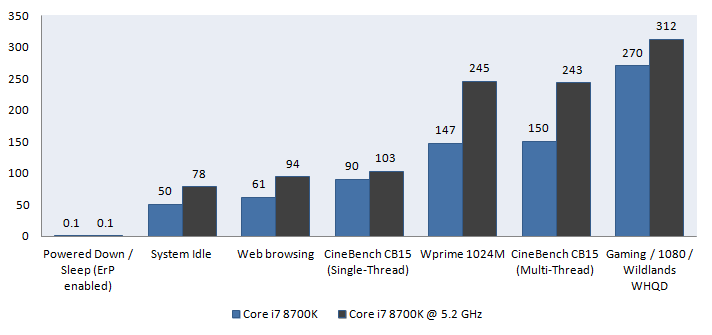Overclocking
Tweaking & overclocking
Overclocking and tweaking then. Always invest in good hardware by the way (MOBO/PSU/Memory/Cooling), the cheaper motherboards often are not well tuned or have broad-spectrum features for enthusiast overclocking. Also get yourself a good power supply and proper processor cooling. Overclocking with a many-core processor (doesn't matter if that is Intel or AMD) is more complicated than you expect it to be. Overclocking multi-core on a high clock frequency is a relatively easy to do job, but is managed best from the BIOS. The Guru3D reader-base overclocks mostly from the BIOS to try and find the maximum stable limit. The generic overclock procedure for multiplier based overclocking is as follows:
Your reachable target for Coffee Lake is 5 GHz and 5.2 GHz with a good processor.
- Leave base clock (bus) for what it is right now (100 MHz)
- Set the per core multiplier at a maximum of your liking:
- Example 1: 100MHz x 50 = 5000 MHz
- Example 2: 125MHz x 40 = 5000 MHz
- Increase CPU voltage; though AUTO often works fine on many motherboards you can do it manually as well. Start at 1.35 ~ 1.40 volts and work your way upwards into a state of equilibrium in perf and cooling temps.
- Make sure your processor is properly cooled as adding voltage = more heat
- Save and Exit BIOS / uEFI
In our case we got all cores running at 5200 MHz, however this results in extra power consumption and heat levels. Our Corsair LCS cooler was barely capable of cooling the proc enough as shown below, roughly 1.40 Volts is needed and obviously we enabled the XMP profile on the memory for dual-channel 3200 MHz.
The temps run high when overclocked over 5.0 GHz - in this case we hit 85 Degrees C easily with the H110 LCS from Corsair.
Power Consumption
Adding extra voltage on the CPU for the OC also has an adverse effect on the overall energy consumption. Under stress and overclocked we all of a sudden use roughly 380 Watt under full processor load (!). That is power consumption for the whole PC measured at the wall socket side including a GeForce GTX 1080 in idle. Overclocked in idle your system will use roughly 10 to 15 Watts more on average. Below an example of another setup, not this particular one, to observe and understand the effect of an overclock a bit better.
Some OC Scores
Prime at defaults sits at around 118 Seconds on 1M workloads, you just shaved off ~19 seconds with this tweak.
1400 CB (give or take) looks to be the default score for the 8700K. At 5.2 GHz you are reaching 1686 points. BTW some people asked, that is 227 CB for a single 5.2 GHz thread OC btw.





